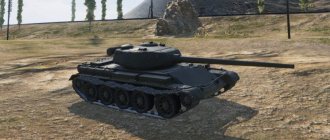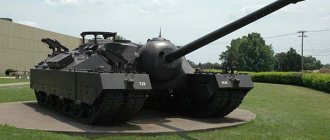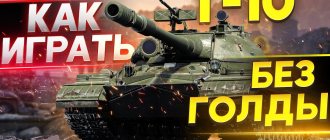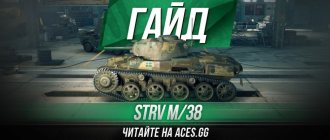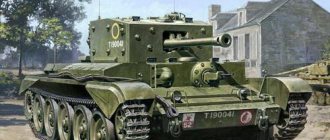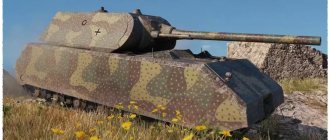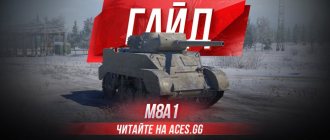KV-3 is an experienced Soviet heavy tank from World War II, designed on the basis of the KV-1 tank. The project was not completed and only one working copy was built, sent to the front, its fate is unknown.
In the WoT game, this heavy tank is presented in the development branch of Soviet equipment at the seventh level. Before the latest update, the heavy weapon was of no interest, since due to its slowness it was very heavily punished by artillery and could only show itself on a small part of the city maps.
With the rebalance of land mines, the situation changed and this heavy weapon unexpectedly became one of the best TTs of its level. Getting into battles with 9s, it still remains weak and requires very careful play (like any vehicle against machines two levels higher), but in fairly regular battles at the top of the list, it has turned into a real steel monster on the battlefield .
Let's look at this tank in a little more detail.
TTX
There are no conventions for the tank - all the top modules are installed and we see the following picture:
What's remarkable about it? First of all, good one-time damage of 390 units. and decent armor penetration. Per shot, the tank removes about a third of a classmate’s HP, which is a lot.
Next you can see excellent armor for its level in the forehead and sides. Don’t be fooled by the numerically thin armor of the turret – due to its rounded shape, it is quite difficult to penetrate. Strength is also good for the seventh level - 1400 units.
Among the disadvantages, it is worth noting the low speed and long aiming of the gun, however, for a tank intended for close combat, these are not very critical parameters.
An excerpt characterizing the KV-3
To understand the degree of exhaustion of the Russian army, you only need to clearly understand the significance of the fact that, having lost no more than five thousand people wounded and killed during the entire movement from Tarutino, without losing hundreds of people as prisoners, the Russian army, which left Tarutino numbering one hundred thousand, came to Red in the number of fifty thousand. The rapid movement of the Russians after the French had just as destructive an effect on the Russian army as the flight of the French. The only difference was that the Russian army moved arbitrarily, without the threat of death that hung over the French army, and that the backward sick of the French remained in the hands of the enemy, the backward Russians remained at home. The main reason for the decrease in Napoleon's army was the speed of movement, and the undoubted proof of this is the corresponding decrease in Russian troops. All of Kutuzov’s activities, as was the case near Tarutin and near Vyazma, were aimed only at ensuring, as far as was in his power, not to stop this movement disastrous for the French (as the Russian generals wanted in St. Petersburg and in the army), but assist him and facilitate the movement of his troops. But, in addition, since the fatigue and huge loss that occurred in the troops due to the speed of movement appeared in the troops, another reason seemed to Kutuzov to slow down the movement of the troops and to wait. The goal of the Russian troops was to follow the French. The path of the French was unknown, and therefore the closer our troops followed on the heels of the French, the greater the distance they covered. Only by following at a certain distance was it possible to cut the zigzags that the French were making along the shortest path. All the skillful maneuvers that the generals proposed were expressed in the movements of troops, in increasing the transitions, and the only reasonable goal was to reduce these transitions. And Kutuzov’s activity was directed towards this goal throughout the entire campaign, from Moscow to Vilna - not by chance, not temporarily, but so consistently that he never betrayed it. Kutuzov knew not with his mind or science, but with his whole Russian being, he knew and felt what every Russian soldier felt, that the French were defeated, that the enemies were fleeing and it was necessary to see them out; but at the same time, he felt, along with the soldiers, the full weight of this campaign, unheard of in its speed and time of year. But to the generals, especially not Russians, who wanted to distinguish themselves, to surprise someone, to take some duke or king prisoner for something - it seemed to the generals now, when every battle was disgusting and meaningless, it seemed to them that now was the time fight and defeat someone. Kutuzov only shrugged his shoulders when, one after another, he was presented with plans for maneuvers with those poorly shod, without sheepskin coats, half-starved soldiers, who in one month, without battles, had melted to half and with whom, under the best conditions of ongoing flight, it was necessary to go to the border the space is larger than that which was traversed. In particular, this desire to distinguish itself and maneuver, overturn and cut off was manifested when Russian troops encountered French troops. This is how it happened near Krasnoye, where they thought to find one of the three columns of the French and came across Napoleon himself with sixteen thousand. Despite all the means used by Kutuzov in order to get rid of this disastrous clash and in order to save his troops, for three days at Krasny the exhausted people of the Russian army continued to finish off the defeated gatherings of the French. Toll wrote the disposition: die erste Colonne marschiert [the first column will go there then], etc. And, as always, everything was done not according to the disposition. Prince Eugene of Wirtemberg shot at the fleeing crowds of Frenchmen from the mountain and demanded reinforcements, which did not come. The French, running around the Russians at night, scattered, hid in the forests and made their way further as best they could. Miloradovich, who said that he did not want to know anything about the economic affairs of the detachment, which could never be found when he was needed, “chevalier sans peur et sans reproche” [“knight without fear and reproach”], as he called himself , and eager to talk with the French, sent envoys demanding surrender, and lost time and did not do what he was ordered. “I give you guys this column,” he said, driving up to the troops and pointing to the cavalrymen at the French. And the cavalrymen on thin, tattered, barely moving horses, urging them on with spurs and sabers, at a trot, after great exertion, drove up to the donated column, that is, to a crowd of frostbitten, numb and hungry Frenchmen; and the donated column threw down its weapons and surrendered, which it had long wanted. At Krasnoe they took twenty-six thousand prisoners, hundreds of cannons, some kind of stick, which was called a marshal's baton, and they argued about who had distinguished himself there, and were pleased with that, but they very much regretted that they did not take Napoleon or at least some hero, Marshal, and reproached each other and especially Kutuzov for this. These people, carried away by their passions, were blind executors of only the saddest law of necessity; but they considered themselves heroes and imagined that what they did was the most worthy and noble thing. They accused Kutuzov and said that from the very beginning of the campaign he had prevented them from defeating Napoleon, that he only thought about satisfying his passions and did not want to leave the Linen Factories because he was at peace there; that he stopped the movement near Krasny only because, having learned about Napoleon’s presence, he was completely lost; that it can be assumed that he is in a conspiracy with Napoleon, that he is bribed by him, [Wilson's Notes. (Note by L.N. Tolstoy.) ], etc., etc. Not only did contemporaries, carried away by passions, say so, but posterity and history recognized Napoleon as grand, and Kutuzov: foreigners as cunning, depraved , a weak old court man; Russians - something vague - some kind of doll, useful only by its Russian name... In the 12th and 13th years, Kutuzov was directly blamed for mistakes. The Emperor was dissatisfied with him. And in history, written recently by order of the highest, it is said that Kutuzov was a cunning court liar who was afraid of the name of Napoleon and with his mistakes at Krasnoye and near Berezina deprived the Russian troops of glory - a complete victory over the French. [The history of Bogdanovich in 1812: characteristics of Kutuzov and reasoning about the unsatisfactory results of the Krasnensky battles. (Note by L.N. Tolstoy.)] This is not the fate of great people, not grand homme, whom the Russian mind does not recognize, but the fate of those rare, always lonely people who, comprehending the will of Providence, subordinate their personal will to it. The hatred and contempt of the crowd punish these people for their insight into higher laws. For Russian historians - it’s strange and scary to say - Napoleon is the most insignificant instrument of history - never and nowhere, even in exile, who did not show human dignity - Napoleon is an object of admiration and delight; he's grand. Kutuzov, the man who, from the beginning to the end of his activity in 1812, from Borodin to Vilna, without ever changing one action or word, shows an extraordinary example in history of self-sacrifice and consciousness in the present of the future significance of the event, – Kutuzov seems to them like something vague and pitiful, and when talking about Kutuzov and the 12th year, they always seem to be a little ashamed. Meanwhile, it is difficult to imagine a historical person whose activity would be so invariably and constantly directed towards the same goal. It is difficult to imagine a goal more worthy and more consistent with the will of the entire people. It is even more difficult to find another example in history where the goal that a historical figure set for himself would be so completely achieved as the goal towards which all of Kutuzov’s activities were directed in 1812. Kutuzov never spoke about the forty centuries that look out from the pyramids, about the sacrifices he makes for the fatherland, about what he intends to do or has done: he didn’t say anything about himself at all, didn’t play any role, always seemed to be the simplest and most ordinary a person and said the simplest and most ordinary things. He wrote letters to his daughters and m me Stael, read novels, loved the company of beautiful women, joked with generals, officers and soldiers and never contradicted those people who wanted to prove something to him. When Count Rastopchin on the Yauzsky Bridge rode up to Kutuzov with personal reproaches about who was to blame for the death of Moscow, and said: “How did you promise not to leave Moscow without fighting?” - Kutuzov replied: “I will not leave Moscow without a battle,” despite the fact that Moscow had already been abandoned. When Arakcheev, who came to him from the sovereign, said that Yermolov should be appointed chief of artillery, Kutuzov replied: “Yes, I just said that myself,” although a minute later he said something completely different. What did he care, the only one who then understood the whole enormous meaning of the event, among the stupid crowd surrounding him, what did he care whether Count Rostopchin attributed the disaster of the capital to himself or to him? He could be even less interested in who would be appointed chief of artillery.
Equipment and ammunition
Of the equipment, the following equipment turned out to be most effective: a valve, a rammer, and an improved sight. Although another quite effective option is a valve, rammer, turning mechanisms.
It is imperative to carry 10-15 sub-calibers in the ammunition load for battles with 8-9, where they will be needed. It is also advisable to load 3-5 high-explosive shells for lightly armored vehicles. In general, the ammunition load is quite large and fully accommodates everything required for comfortable shooting.
Modules:
Turrets/guns
| Lv. | Tower | Armor (mm) | Rotation (deg/sec) | Review (m) | Weight, kg) | Price (credits) |
| VI | T-220 | 100/100/100 | 24 | 330 | 10 000 | 10 630 |
Compatible weapons:
| Lv. | gun | Penetration (mm) | Damage (HP) | Rapid fire (rounds/min) | Spread (m/100m) | Mixing (c) | BC | Weight, kg) | Price (credits) |
| VII | 107 mm ZiS-6 | 167/219/54 | 300/300/360 | 6.19 | 0.45 | 3.4 | 61 | 2 400 | 68 290 |
| VI | 85 mm F-30 | 120/161/43 | 160/160/280 | 11.76 | 0.42 | 3.4 | 91 | 1 550 | 48 000 |
| VI | 85 mm S-31 | 119/159/43 | 160/160/280 | 11.76 | 0.42 | 3.4 | 91 | 1 500 | 49 200 |
| Lv. | Tower | Armor (mm) | Rotation (deg/sec) | Review (m) | Weight, kg) | Price (credits) |
| VII | KV-3 | 130/130/130 | 22 | 340 | 12 300 | 21 930 |
Compatible weapons:
| Lv. | gun | Penetration (mm) | Damage (HP) | Rapid fire (rounds/min) | Spread (m/100m) | Mixing (c) | BC | Weight, kg) | Price (credits) |
| VI | 85 mm F-30 | 120/161/43 | 160/160/280 | 11.76 | 0.42 | 3.4 | 79 | 1 550 | 48 000 |
| VI | 85 mm S-31 | 119/159/43 | 160/160/280 | 11.76 | 0.42 | 3.4 | 79 | 1 500 | 49 200 |
| VII | 107 mm ZiS-6 | 167/219/54 | 300/300/360 | 6.19 | 0.45 | 3.4 | 55 | 2 400 | 68 290 |
| VII | 100 mm D-10T | 175/235/50 | 250/250/330 | 6.45 | 0.42 | 2.9 | 47 | 2 257 | 78 180 |
| VII | 122 mm D-2-5T | 175/217/61 | 390/390/530 | 4.08 | 0.46 | 3.4 | 38 | 2 600 | 84 980 |
| VIII | 122 mm D-25T | 175/217/61 | 390/390/530 | 4.88 | 0.46 | 3.4 | 38 | 2 590 | 125 140 |
Engines
| Lv. | Engine | Power (hp) | Fire probability (%) | Weight, kg) | Price (credits) |
| VI | AT 5 | 600 | 15 | 750 | 27 860 |
| VII | V-2IS | 600 | 15 | 750 | 36 000 |
| VIII | V-2SN | 750 | 15 | 750 | 34 000 |
Chassis
| Lv. | Chassis | Max. load (t) | Turning speed (gr/sec) | Rmin | Weight, kg) | Price (credits) |
| VI | KV-3 | 68.25 | 16 | B/2 | 14 200 | 10 720 |
| VII | KV-3 Bis | 71.8 | 18 | B/2 | 14 200 | 18 200 |
Radio stations
| Lv. | Radio station | Communication range (m) | Weight, kg) | Price (credits) |
| V | 10R | 360 | 100 | 3 660 |
| VII | 10RK | 440 | 100 | 18 600 |
| IX | 12RT | 625 | 110 | 33 600 |
| X | R-113 | 730 | 80 | 52 200 |
Gameplay
The tank shows itself best when it gets to the top of the list, however, the main feature in the new realities is the readability of almost all cards. The author specially selected two fights on those maps where this heavyweight previously felt very uncomfortable due to the rain from his suitcases. Now the situation has changed and this can be seen in practice.
Murovanka
The map for a TT is pretty disgusting, especially for a TT with no overview. Seeing the equipment being dispersed, the most reasonable decision turned out to be an aggressive play in the center.
And here are the new realities of art - a direct hit without damage. Another advantage of low levels for such vehicles is that the tank punishes careless opponents, of which there are quite a lot in such battles, very painfully.
And those who are completely unwary are quickly sent to the hangar.
In principle, this fight is a bit like a theater of the absurd, since after arriving at the center some kind of circus began, performed by the opponents.
First of all, the main enemy heavy was found in a position that was absolutely crazy for him.
Next, the SU-100 went for a kamikaze attack and, after taking a direct shot at the side, decided to kill the seventy-ton tank with a ram.
After this, the enemy tank tried to twist two strands at the same time.
Well, the apotheosis was during this time that the Frenchman failed to kill the KV-3 and did not change his position, but safely went to the next battle.
Based on the results of the battle:
For a map that is far from heavy-friendly and has three arts, it’s quite good.
Karelia Sturm
Everyone knows this mode and this map, again quite difficult for blind TTs. Random threw the KV-3 onto the left flank and in essence it was just pushing the direction, almost without stopping.
It all started with a crazy self-propelled gun that imagined itself to be a firefly.
The enemy did not appear down the hill and in this case, without any problems, the TT begins to push the direction. By the way, it is worth noting the acting armor of this TT.
And also the helplessness of artillery. 59 HP on a direct hit is ridiculous.
Finding itself in some kind of encirclement, the tank was placed in a diamond shape and began to absorb damage.
At the same time, I periodically caught opponents in my sights, although at long distances this is quite difficult.
In general, the tank drove like a steel roller through enemy positions - and this is the beauty of this TT, with a reasonable approach it can crush everything, including opponents and important directions.
At the end of the battle, pay attention to the tanked damage - and this is in open areas. It is worth noting the opposing team - the KV-3 is also the leader in terms of results.
Links
Medium tanks T-34 T-34-57 A-43/T-34M ·
A-44
·
KV-13
·
T-43
· T-34-85 · T-44 ·
T-34-100Heavy tanks KV-1 · KV-2 · T-150 ·
KV-220
·
KV-3
·
KV-4
· KV-1s ·
KV-5
·
KV-1K
· KV-85 ·
KV-9
·
KV-100
·
KV-122
·
EKV
· IS-1 · IS-2 ·
Object 244
·
Object 245
·
Object 248
· IS-3 ·
ST-1
·
IS-5
·
IS-6Flamethrower and chemical tanks KV-6 · KV-8 · OT-34 ·
KV-12Surrogate tanks NI-1 · Light self-propelled guns ZIS-41 ·
76.2 mm assault support gun
·
I13.73-SU
·
I13.75-SU
·
I13.76-SU
· SU-76 ·
SU-71
·
SU-15
·
SU-16
·
SU-IT-45
·
SU-74A
·
SU-74B
·
SU-74D
·
GAZ-75
·
NATI-TSAKB
·
Tank destroyer (MVTU project)
·
SU-85A
·
KSP-76
·
OSU-76
·
SU-85BMedium self-propelled guns U-34 · SG-122 · SU-122 ·
SU-D25
SU-122М
·
SU-85-I
· SU-85 ·
SU-122-III
·
SU-85-IV
· SU-76i ·
SU-D15
·
SU-85BM -I/SU-85BM-II
· SU-100 ·
SU-122P
·
SU-122-44
·
ESU-100
·
SU-100M-1
·
SU-100M-2
·
SU-101 · SU-102Heavy self-propelled guns KV-7 ·
U-18
·
U-19
· SU-152 ·
S-51
·
S-59
· ISU-152 · ISU-122 · ISU-122S ·
ISU-152-1
ISU-152-2
· -
122-1
·
ISU-122-3
·
ISU-130
·
ISU-152 model 1945Surrogate self-propelled guns ZIS-30 · HTZ-16 ZSU ZIS-43 ·
T-90
·
SU-72
·
SU-11
· ZSU-37MLRS BM-8-24 BM-13-16 BM-8–48 BM-13N BM-31-12 Armored cars LB-62 · · BA-64
Armored personnel carriers TB-42 ·
BA-64E
·
B-3Armored tractors Object 42 ·
ZIS-22MB
·
ATP-1Combat snowmobiles and snowmobiles TsAGI-AHT-IV · NKL-16 · 02SS · NKL-26 · RF-8 (GAZ-98) ·
BA-64-ZTorpedo wedges ET-1-627 italics experimental samples and those that did not go into mass production were identified
Top equipment
| Price | 1.390.000 kr. |
| Strength | 1400 HP |
| Weight/max. | 68.2/71.8 t. |
| Power | 750 hp |
| Speed | 32/10 km/h. |
| Agility | 18 °/s |
| Frame | 120/90/90 mm. |
| Tower | 130/115/115 mm. |
| Ammunition | 38 pcs. |
| Damage | 390/390/465 HP |
| Breakthrough | 175/217/61 mm. |
| Reload | 12.3 sec. |
| GN speed | 22 °/s |
| Angles VN | -7…+24° |
| Review | 340 m |
| Connection | 730 m |
Crew:
- Crew commander;
- Gunner;
- Driver mechanic;
- Radio operator;
- Charging;
- Charging.
Learning additional skills for the crew:
Standard crew:
| 1 | 2 | 3 | 4 |
For the first slot, we teach all crew members, except the commander, the “ Repair” , and for the commander the “ Sixth Sense” skill - the “Repair” skill speeds up the repair of damaged modules, and the “Sixth Sense” will allow you to determine whether his tank has been detected by the enemy. Also, all crew members need to learn the additional skill “ Combat Brotherhood” , which will improve the level of proficiency in the specialty - be sure to learn it all at once, preferably used in the second or third slot.
- the Eagle Eye skill , which increases the viewing range.
- For the gunner we learn the skill “ Smooth turret rotation” , which reduces the spread when turning the turret; and the Sniper , which increases the chances of causing damage to modules and crew members.
- For the driver mechanic, we learn the “ Smooth Move” , which reduces the dispersion of the gun in motion; and the Off-Road King , which reduces drag on soft to medium ground when driving.
- For the radio operator, we learn the “ Radio Interception” , which increases the viewing range; and the Inventor , which increases the radio's communication range by 20% .
- “Desperate” skill , which reduces the reload time when less than 10% strength remains; and the “Intuition” , which creates the possibility that when changing the type of shells, the desired one is already loaded.
- For the loader, we learn the skill “Non-contact ammo rack ,” which increases the strength of the ammo rack; and the “Intuition” , which creates the possibility that when changing the type of projectile, the desired one is already loaded.
Stories about weapons. KV: the first heavy Soviet tank
Don’t rush to say that the KV was not the first heavy Soviet tank. It was not for nothing that we used the word “combat”. Yes, as a model built in series, the T-35 really became the first Soviet heavy tank. And it was quite suitable for parades. But its combat usefulness turned out to be more than conditional. However, we already wrote about this here: “Stories about weapons. Tank T-35. The most useless in the world?
So, without exaggerating too much, we believe that the KV heavy tank became the first real combat vehicle of the Red Army in this class.
Having encountered a Soviet KV heavy tank in the very first days of the war, the Germans immediately dubbed it the “Ghost”. A machine that could single-handedly fight several opponents at once. A vehicle whose armor was not taken by anti-tank guns. A worthy opponent for any German armored vehicle. And in general, for any armored vehicles of that time.
Today there is a lot of material about this family of tanks. For every taste. From devastating criticism to deification. Accordingly, fans of wartime armored vehicles have already formed a completely opposite opinion about this magnificent or disgusting tank.
However, everyone agrees that during the first period of the war it was indeed the most powerful tank. And it was he who largely endured the hardships of the most difficult time period of the Great Patriotic War.
There are plenty of examples of successful and demonstrative actions by HF crews. From the actions of Kolobanov’s crew near Leningrad to Konovalov’s crew near Voronezh.
And the Germans themselves paid tribute to the combat vehicle, because if they could oppose anything, it was very, very little.
But the overall picture is impressive. And now it’s worth looking at where the KV came from. We are accustomed to viewing combat vehicles from ours today, with modern eyes and brains. Meanwhile, before the start of World War II, no one had any idea what characteristics a heavy tank should have. One could only guess about the effectiveness of this or that design.
The T-35 breakthrough tank we have already mentioned.
Despite the fact that this five-tower giant was put into production, its participation in hostilities was very conditional, as we talked about at one time. A ceremonial tank that quickly disappeared in the first period of the war because it was not brought to perfection, that is, it absolutely did not meet the very requirements of that war.
Only in the second half of the 30s did the USSR finally develop at least some understanding of the very concept of a breakthrough tank. It was then that the famous “S. M. Kirov." The same experienced QMS with two towers, which became the basis for the development of Klim Voroshilov.
Heavy tanks must not only have powerful weapons with 76 mm and 45 mm caliber guns, but also at least 75 mm armor on the sides, which would provide protection not only from a 47 mm gun at all distances, but also from fire from a 76 mm gun at range 800-1000 meters.
The KV tank itself appeared precisely as a smaller copy of the SMK. The designers, by removing the second turret, reduced the length of the vehicle. And quite strongly. For two skating rinks. It is interesting that in general the concept of this tank itself was not considered promising by management.
But there was one person who believed in the concept of a single-turret breakthrough tank. This is the head of the ABTU of the Red Army, corps commander Pavlov.
It was at his insistence that graduates of the VAMM named after him were sent to develop such a machine. Stalin, who arrived at the Kirov plant to complete their graduation project. By the way, this explains the appearance of A. S. Ermolaev among the project leaders.
Afanasy Semenovich Ermolaev was precisely the head of the diploma project of this group of graduates. Although, in our opinion, another leader, Leonid Egorovich Sychev, is undeservedly not mentioned.
Sychev and Ermolaev managed the tank project together.
It turned out to be a tank. Leading designer Ermolaev presented the car in August 1939 under the symbol O-U. The O-U prototype actually had two guns: 76 mm (L-11) and 45 mm. In addition, three machine guns were installed on the tank - one DK and two DT. In addition to weapons, the vehicle received a diesel engine, torsion bar suspension and armor that was really not penetrated by armor-piercing shells of that time.
The chief designer of the new tank, which by that time had received the name Klim Voroshilov, was Nikolai Leonidovich Dukhov.
During factory tests, the car performed quite well, although numerous deficiencies were discovered. There is a letter from the military representative of the Kirov plant, military engineer 3rd rank Kalivoda, addressed to the People's Commissar of State Control L. Mehlis, which directly states the need for urgent modification of this machine in order to accept it at least as a training vehicle.
In August 1939, the first copy of the KV was manufactured. It is the KV, and not the KV-1, as is erroneously stated in some publications. The one, as paradoxical as it may sound, appeared later than the two.
On November 29, 1939, one day before the start of the Soviet-Finnish War, three promising vehicles were transferred to the 20th Tank Brigade (T-28 tanks) for military testing - SMK, T-100 and KV.
The KV conducted its first battle on December 17, 1939 during the breakthrough of the Khottinensky fortified area of the Mannerheim Line. The car performed quite well. As, indeed, do others. True, the SMK was blown up by a landmine on the third day of testing and was no longer used.
However, the military did not like the low-power gun. The L-11 simply could not cope with the Finnish fortifications. That’s when the idea came up to install a 152-mm howitzer on the KV chassis. The new tank was designated KV-2. And the first version of the car began to be called KV-1.
By the way, the KV was put into service a day after the first battle. December 19, 1939.
This was one of the reasons for abandoning the SMK and T-100. These vehicles, with the same weapon power (more powerful than the KV), were less armored, more difficult to manufacture and heavier than the KV. Although this decision caused a lot of controversy.
Today we can talk a lot about the losses in the first months of the war. Not so much about the losses, but about the fact that many vehicles were simply abandoned by the crews due to malfunctions and lack of fuel. But let's look at those who fought in 1941 on the KV.
The vast majority of heavy tank crews had virtually no training before the first battle. Drivers, according to official data, had 3-5 hours of driving! Even such a small thing as instructions on how to operate a HF was in short supply. One per battalion!
But even under such conditions, the KV made an impression on the enemy. The breakthrough tank was used as a defensive tank. Only an 88 mm anti-aircraft gun, 150 mm field guns and a 105 mm howitzer could take it. The rest of the artillery was only suitable for striking sparks and affecting the auditory receptors of tankers.
The Germans are also diligent students. Six months after the start of the war, German tanks received 50 mm and 75 mm guns, and at the end of 1942 the Tiger (Pz-VI) appeared at the front. "Tigers" hit KVs at a range of 1.5-2 km, while the 76-mm KV cannon could knock out a German vehicle from only 500 meters.
At the same time, the Germans also introduced “Panzerjägerkanone” instead of “Panzerabwehrkanone”. Tank hunter gun instead of the Pak-40 anti-tank gun.
The 75-mm cannon mounted on the chassis almost completely eliminated the superiority of the KV and T-34 in armor. Any hit from this weapon was considered fatal. While 50-mm sub-caliber shells had only 50% of fatal hits. So, in principle, a good KV tank became unnecessary for the army.
But the Red Army did not think of abandoning heavy tanks. The traditional confrontation between armor and projectile began. Designers began to weight the vehicles with more powerful armor. The heavy tanks of the 1940-41 period were really heavy. Suffice it to say that the lightest such prototype weighed 60 tons!
And the armament of such vehicles inspired respect. At least 100 mm! An example of such a monster is the KV-7 prototype. It is better known to specialists under a different name - KV-220. A classic assault tank in the understanding of that time. Armed with three (!) guns. The main gun is 76 mm and two 45 mm guns.
Such “artillery” played a cruel joke on the tank. He did not shoot where the gunner was pointing, but where the tank itself wanted. Even Voroshilov, after testing this prototype, expressed himself very figuratively: “Until today, I considered artillery an exact science.”
Another interesting prototype is a tank with a pair of 76 mm guns. Can you imagine this car?
There were prototypes with a howitzer gun (KV-9). There was even a prototype with missile weapons - the KV-1 KRAST. The designation “short tank missile and artillery system” was exactly what this tank had.
All of what was mentioned above is a rather complex decision. And in war conditions, solutions must be easy, cheap and technologically advanced. The simplest of these solutions seemed to be simply increasing the reservation on existing vehicles. Moreover, this applied not only to the KV, but also to the T-34 and T-28.
These prototypes had the index "E". Additional masks were called screens. Hence E is shielded. A simple solution is not always a good one. The vehicles were designed for a certain weight and, accordingly, weighting led to a significant deterioration in the dynamic qualities of the tanks.
In the case of KV, it generally looked stupid. The fact is that already in 1941 it was understood that the vehicle was over-armored. The desire to make a fortress on tracks led to completely unnecessary millimeters of armor on the sides and stern. Most of the hits were in the forehead.
The solution was suggested by the military themselves. Units and formations often received complaints about the low maneuverability and speed of our heavy tanks. The commanders attributed heavy losses to this feature of the “fortresses.” The designers were tasked with increasing the speed of the tank.
A solution to the problem was found in the design bureau of the Chelyabinsk Tractor Plant. After analyzing tank losses in battles, ChTZ came to the same conclusion that we voiced above. And already in May 1942 they proposed a new tank - the KV-1S.
We don’t know where the decoding “C” came from as a special or high-speed one. Officially, this vehicle was called the KV-1 fast-moving tank. The speed has indeed been significantly increased. Up to 43 km/h. Due to what? By booking.
By July 1942, this particular modernized version of the first series of the tank appeared. The armor on the sides was reduced to 60 mm. Armor casting began to be used, which also reduced weight. The design of the tower was changed to reduce its thickness. At the same time, a commander's turret appeared on it.
The KV-1S was equipped with a new gearbox, final drives, a new main clutch, and a new cooling system. Other materials were also used for the chassis. The vehicle received lightweight rollers, lightweight tracks, and a lightweight sloth.
There was an incident with this car. The KV-1S tank was put into service more than a week before the end of state tests, on August 20, 1942. And the car was tested until August 26, 1042. Thus, the vehicle went into production even before it was put into service.
It seems that all the requirements were taken into account, but... But it turned out that the KV-1S “didn’t make it.” Everything was fine, but in 1943 they sent Tigers and Panthers to the tank forces of the Wehrmacht, whose guns coped quite well with KV armor, but our tank could reciprocate with great difficulty. The 76 mm gun clearly required replacement. In addition, the strengthening of the armor of the classic Pz-IV as a whole completely negated all work on the HF.
First of all, a more powerful weapon was required. For example, the 85 mm D-5 gun.
The gun and even the turret were already ready. True, they were intended for the new tank - “Joseph Stalin”. Taking someone else's tower was quite difficult. The fact is that the turret for the IS was made in Chelyabinsk, and the KV chassis was produced in Leningrad. Therefore, the Kirov plant created its own model of the tower.
Ultimately, the KV-85 still received a turret from the IS, but one single copy of the “original” KV-85 has survived to this day and stands as a monument on Stachek Avenue in St. Petersburg. This is exactly the same prototype with its own (Leningrad) turret.
But, alas, time has not been kind to the KV-85 with an IS turret, and they can only be seen in wartime photographs.
The machine that you can see, touch and inspect, the one you see in our photos, is another modification of the KV. More precisely, KV-8.
Our Soviet flamethrower tank, which sowed panic among German soldiers and officers. “Everything was burning!” - it's about him. Only 139 units of these vehicles, together with the KV-8S, were produced. Few? It's hard to say; it depends on the specifics of the application.
At first glance, the car is almost no different from a regular one. Cannon, coaxial machine gun, regular chassis. In fact, the principle “don’t believe your eyes” applies here.
A gun of a decent caliber, seemingly normal for a heavy tank, is nothing more than an imitation. In fact, this is a 45 mm gun in a camouflage casing. And there is no machine gun in its usual place! There is an ATO-41 “Serpent Gorynych” flamethrower there. ATO - automatic tank flamethrower.
Effective at a range of up to 130 meters - there was nothing alive left! The Germans, seeing the KV-8 or T-34 from the ATO, simply fled from their positions. Another question is that identifying the flamethrower tank was not easy.
Actually, “Snake Gorynych” is the name given to the T-34 tank with ATO. Later the name spread to the KV, and to the flamethrower itself.
And this miracle of technology was produced (at that time no one else in the world produced such weapons) in the village of Karabalykh, Kustanai region. In an ordinary grain farm. These are the kinds of miracles that happen.
And we will finish our story about why the KV tank is eternal. That's right - eternal! Eternity is the short duration of life of a single specimen or individual. Eternity is a continuation in descendants!
The descendant of the one who died in the first months of the war, the one who burned defending the retreating troops, became the most formidable, strongest tank of the Second World War! Yes, the family of heavy ISs are direct descendants of the clumsy, poorly armed KVs, with many defects and design errors.
KV simply changed his last name. The KV-13, also known as object 233, a heavy armored medium tank created at ChTZ in 1942, became the IS-1 tank. But the KV-9 with the 122-mm U-11 tank howitzer, object 234, became the IS-2.
The creation of new equipment, especially military equipment, is always associated with many problems that are identified already in the process of pilot production. But most of the problems are revealed in battle. This is especially true for completely new developments.
“Klim Voroshilov” was the first Soviet heavy tank; the T-35 is generally difficult to consider as a combat vehicle. So the KV and its further development can be considered a machine that influenced not only domestic tank building, but also Western schools of designers. So in any modern tank there is a small part of it.
Order of studying modules:
| Chassis | gun | Tower | gun | gun | Engine | Engine | Radio station | Radio station | |
| Result: Experience: 101140 Credits: 474340 | |||||||||
| KV-3 Bis | 107 mm ZiS-6 | KV-3 | 122 mm D-2-5T | 122 mm D-25T | V-2IS | V-2SN | 12RT | R-113 | |
| 6320 experience - 18200 credits | 14400 experience - 68290 credits | 7120 experience - 21930 credits | 17,000 experience - 84,980 credits | 19000 experience - 125140 credits | 11,000 experience - 36,000 credits | 12,000 experience - 34,000 credits | 5600 experience - 33600 credits | 8700 experience - 52200 credits |
More details on the research.
- The KV-3 Bis chassis will add carrying capacity and also increase the maneuverability of the tank.
- 107 mm ZiS-6 gun - provides access to the top turret and weapons.
- KV-3 turret - increases armor and viewing range.
- 122 mm D-2-5T gun - provides access to the top gun.
- The 122 mm D-25T gun has high one-time damage and normal penetration.
- The V-2IS and V-2SN engines significantly increase the dynamics.
- Radio stations 12RT and R-113 - increase communication range.
History of changes:
Update 0.6.3.7
- Cross-country ability has been slightly improved.
Update 0.7.0
- Transfer to a new booking system (16 groups + screens).
Update 0.7.3
- The tank was transferred from the sixth level to the seventh, 122 mm D-25T and S-31 guns were added.
Update 0.7.5
- Added 100 strength points due to the introduction of level 10 ST and PT into the game.
Update 0.8.6
- Profitability increased by 7%.
Update 0.8.8
- The power of the V-5 engine was changed from 560 to 600 hp. With.
- The reload time of the 100 mm D-10T gun has been changed from 8.6 seconds. up to 9.3 sec.
Update 0.9.13
- The tank has been redesigned with a new visual quality.
